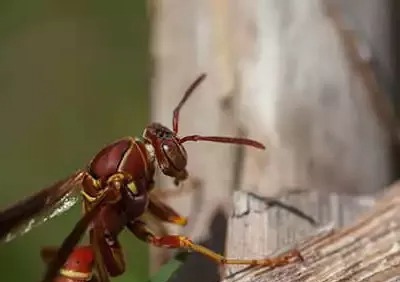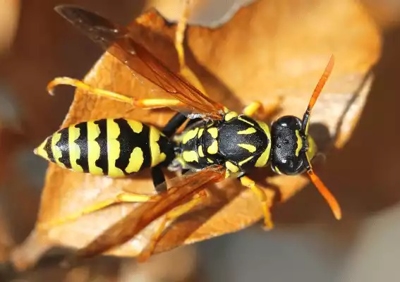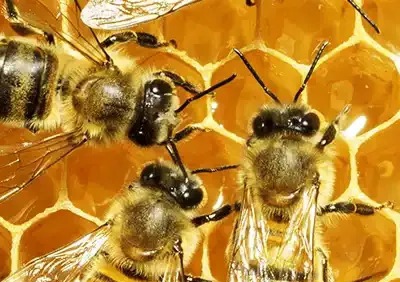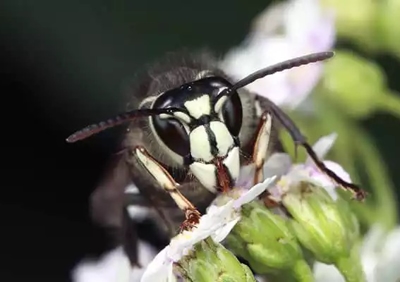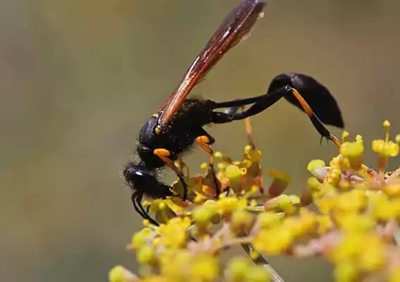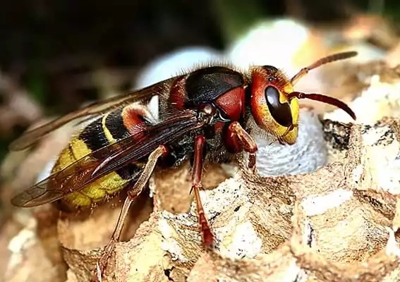
Learn About Stinging Insects
Frequently Asked Questions
-
Where do stinging insects nest?
Where exactly a stinging insect will nest is species dependent. Paper wasps create their umbrella-shaped nests from paper-like material that they create from saliva and wood fibers. Paper wasps typically hang their nests from trees, shrubs, door frames, roof soffits, and inside of attics.
Yellow jackets usually create their nests in the ground, although if given the opportunity they will place their nest under roof eaves, behind walls voids, and inside of attics.
Honey bees like to place their nests inside of tree hollows, crevices, between rocks, in tree stumps, and in other hollow areas.
-
Are stinging insects dangerous?
Yes, stinging insects are considered to be dangerous. Their stings are not only painful and leave behind raised red welts, but the venom that they inject is strong enough to cause health problems in people.
Depending on the person, the venom can cause a severe allergic reaction or even anaphylactic shock - in either case immediate medical attention should be sought.
-
Why do I have a stinging insect problem?Stinging insects are attracted to food sources such as insects, nectar, and pollen. Swimming pools, ornamental ponds, and other water sources may also attract them.
-
How do I get rid of a stinging insect problem?If you’ve discovered a nest on, in or near your home or building, contact Keller’s to discuss treatment options. In business for over 20 years, our team of licensed pest control professionals have the knowledge, skills, and tools needed to resolve your stinging insect problem.

-
 Paper WaspsThese stinging insects have long legs that hang down when they are in flight; they also have a pinched waist that is often associated with other wasp species. Their bodies are black or brown in color, and depending on the exact species, they can have yellow markings, orange markings, or a combination of both yellow and orange markings. Their wings are grayish in color, and paper wasps have a smooth stinger, which allows them to sting their victim repeatedly.
Paper WaspsThese stinging insects have long legs that hang down when they are in flight; they also have a pinched waist that is often associated with other wasp species. Their bodies are black or brown in color, and depending on the exact species, they can have yellow markings, orange markings, or a combination of both yellow and orange markings. Their wings are grayish in color, and paper wasps have a smooth stinger, which allows them to sting their victim repeatedly. -
 Yellow JacketsYellow jackets vary in appearance depending on the species but typically have either banded yellow and black abdomens or banded white and black abdomens. Yellow jackets appear similar to paper wasps, but they have shorter legs and wider abdomens. They also have a smooth stinger.
Yellow JacketsYellow jackets vary in appearance depending on the species but typically have either banded yellow and black abdomens or banded white and black abdomens. Yellow jackets appear similar to paper wasps, but they have shorter legs and wider abdomens. They also have a smooth stinger. -
 Honey BeesHoney bees have fuzzy abdomens and are dark brown to black in color and are banded with either yellow or orange. Their stings are barbed which means that they can only sting once.
Honey BeesHoney bees have fuzzy abdomens and are dark brown to black in color and are banded with either yellow or orange. Their stings are barbed which means that they can only sting once. -
 Bald-Faced HornetsBald-faced hornets are actually not hornets at all. In fact, they are more closely related to yellow jackets and paper wasps. They are referred to as “hornets” because of their large size; adults can grow to between ½ and ¾ of an inch in length, with queens being the largest members. Bald-faced hornets have long, thin, wasp-like bodies that are black, with an off-white pattern covering most of the face. This gives them the appearance of having a “bald” face. They also have an off-white color pattern at the end of the abdomen and on the thorax. Bald-faced hornets can be quite aggressive and their paper-like nests are found up off of the ground
Bald-Faced HornetsBald-faced hornets are actually not hornets at all. In fact, they are more closely related to yellow jackets and paper wasps. They are referred to as “hornets” because of their large size; adults can grow to between ½ and ¾ of an inch in length, with queens being the largest members. Bald-faced hornets have long, thin, wasp-like bodies that are black, with an off-white pattern covering most of the face. This gives them the appearance of having a “bald” face. They also have an off-white color pattern at the end of the abdomen and on the thorax. Bald-faced hornets can be quite aggressive and their paper-like nests are found up off of the ground -
 Mud DaubersMud daubers are a solitary species of stinging insect; they were named after the unique nests they create out of mud and other organic materials. They often create their nests on the outside of homes and other structures. Mud daubers are black wasps that have yellow markings and extremely thin structures that connect the thorax and abdomen together (pedicel). The elongated pedicel makes the body look as though it has been “stretched.” Inside nests, females create hundreds of individual “cells” that house their developing young. Female mud daubers hunt and paralyze spiders to feed their young. Mud daubers are not an aggressive species of stinging insect and rarely sting people, though care should still be taken around them.
Mud DaubersMud daubers are a solitary species of stinging insect; they were named after the unique nests they create out of mud and other organic materials. They often create their nests on the outside of homes and other structures. Mud daubers are black wasps that have yellow markings and extremely thin structures that connect the thorax and abdomen together (pedicel). The elongated pedicel makes the body look as though it has been “stretched.” Inside nests, females create hundreds of individual “cells” that house their developing young. Female mud daubers hunt and paralyze spiders to feed their young. Mud daubers are not an aggressive species of stinging insect and rarely sting people, though care should still be taken around them. -
 European HornetsEuropean hornets, commonly referred to as giant hornets or brown hornets, are very large. These hornets are the only “true hornet” native to the United States. Adults are brown in color with yellow stripes on their abdomen. Faces are paler in color than the rest of their bodies. European hornets grow to between ¾ and 1 ½ an inch in length. These hornets have a long “full” body, 6 legs, 2 pairs of wings, and antennae. An interesting fact about European hornets is that, unlike most other species of stinging insects, these hornets can be active throughout the night. European hornets, along with delivering painful stings, can cause damage to trees and shrubs by stripping their bark in order to create their nests and feed on sap.
European HornetsEuropean hornets, commonly referred to as giant hornets or brown hornets, are very large. These hornets are the only “true hornet” native to the United States. Adults are brown in color with yellow stripes on their abdomen. Faces are paler in color than the rest of their bodies. European hornets grow to between ¾ and 1 ½ an inch in length. These hornets have a long “full” body, 6 legs, 2 pairs of wings, and antennae. An interesting fact about European hornets is that, unlike most other species of stinging insects, these hornets can be active throughout the night. European hornets, along with delivering painful stings, can cause damage to trees and shrubs by stripping their bark in order to create their nests and feed on sap.

Pests Beware. We Care!
Trust Keller's Pest Control For Reliable Service With Integrity
-
No Obligation Estimates
-
Family-Owned & Operated
-
29+ Years in Business
-
Knowledgeable Technicians
-
Customer Top-Rated
-
No Contracts


-
"Bed Bugs Gone"Keller’s Pest Control is by far the best service we’ve ever had! Patrick Keller is professional, thorough & amiable. The bugs have been gone ever since they first serviced us! We will continue our service can’t recommend them enough.- Sara M.
-
"Longtime Customer"We have been working with Keller’s for a long time and could not be happier with their service and expertise. They are responsive and honest. We appreciate the technicians and the office team. Thank you, Keller’s Pest Control!- Christine S.
-
"Knowledgable & Efficient"The technician was so knowledgeable about my bed bug issue. They came in with a heat machine and eliminated the bug quickly and efficiently. I was able to get my rental back in action the next day! Great company.- Christopher W.
-
"10+ Year Customer"I’ve used Keller’s for pest control at my house for more than 10 years. They have always provided excellent, speedy, and complete service. It's pleasure to do business with them.- Bob W.
-
"Outlined Treatment Plan"The technician was great and clearly explained what issues we were having in our home. They outlined the treatment plan to address those issues and the time frame. Very friendly and we look forward to a great relationship as their happy customer.- Kevin A.
-
"4+ Year Customer"We have used them for over 4 years. Our technician is very knowledgeable and professional. We are gone from the property sometimes as long 4 months and never have any pest issues. We highly recommend Keller’s Pest Control.- Bill B.
-
"They Explained Everything"Keller's was very quick to respond to my call and came to the house at my convenience. They did such a great job at explaining things and I went with the quarterly service plan. Very reasonable pricing and gave us piece of mind.- Ron Q.
-
"Exceptional Company"Keller's Pest Control is exceptional in every way! Their team is knowledgeable, professional, and genuinely dedicated to ensuring a pest-free home. From quickly addressing serious issues to providing regular, reliable maintenance, they’ve exceeded.- Aleks S.
-
"A+ Communication"I've been using Keller's for over three years now and they've been great. I've had some bug problems and they have been very responsive at fixing them even if it meant showing up out of cycle to handle. Communication is key and they get an A+.- Jeff I.

Go With the Team You Trust.
See Our Proud Affiliations, Certifications & Awards

-
 Our Reviews
Our Reviews -
 Read Our Blog
Read Our Blog -
 Save on Service
Save on Service
